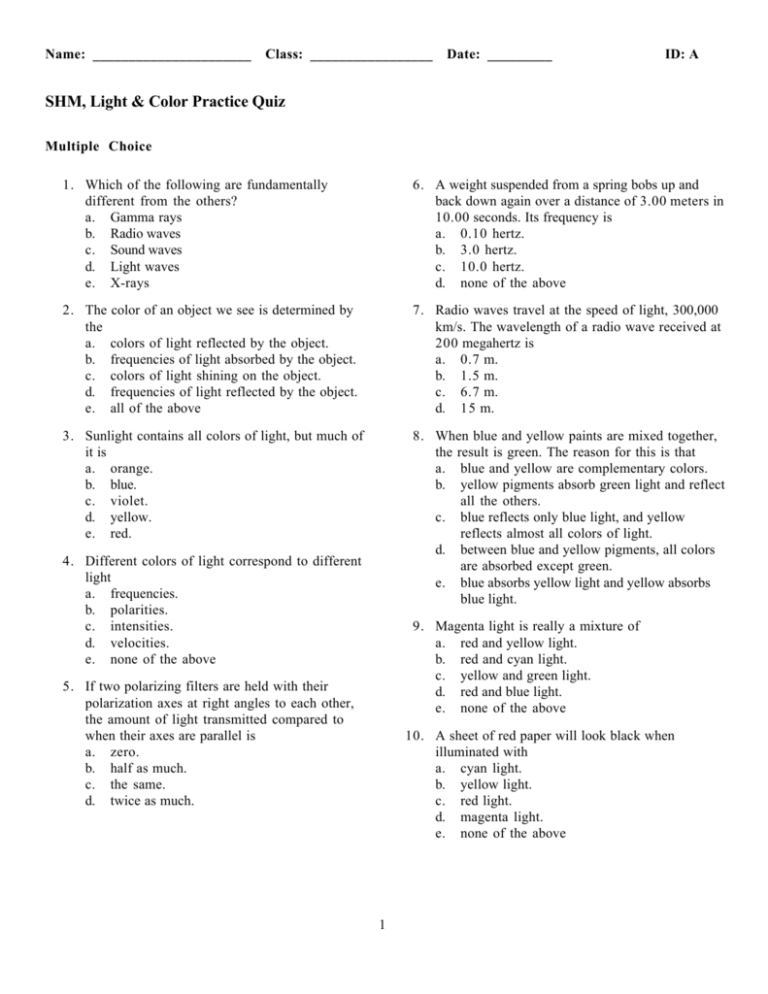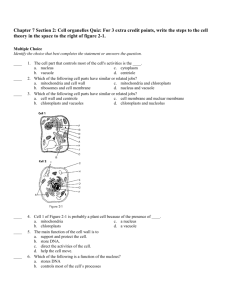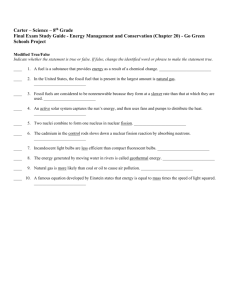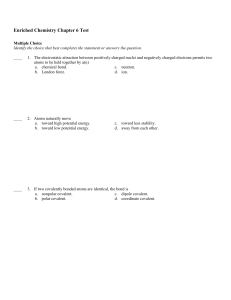SHM, Light & Color Practice Quiz
advertisement

Name: ______________________ Class: _________________ Date: _________ ID: A SHM, Light & Color Practice Quiz Multiple Choice 1. Which of the following are fundamentally different from the others? a. Gamma rays b. Radio waves c. Sound waves d. Light waves e. X-rays 6. A weight suspended from a spring bobs up and back down again over a distance of 3.00 meters in 10.00 seconds. Its frequency is a. 0.10 hertz. b. 3.0 hertz. c. 10.0 hertz. d. none of the above 2. The color of an object we see is determined by the a. colors of light reflected by the object. b. frequencies of light absorbed by the object. c. colors of light shining on the object. d. frequencies of light reflected by the object. e. all of the above 7. Radio waves travel at the speed of light, 300,000 km/s. The wavelength of a radio wave received at 200 megahertz is a. 0.7 m. b. 1.5 m. c. 6.7 m. d. 15 m. 3. Sunlight contains all colors of light, but much of it is a. orange. b. blue. c. violet. d. yellow. e. red. 8. When blue and yellow paints are mixed together, the result is green. The reason for this is that a. blue and yellow are complementary colors. b. yellow pigments absorb green light and reflect all the others. c. blue reflects only blue light, and yellow reflects almost all colors of light. d. between blue and yellow pigments, all colors are absorbed except green. e. blue absorbs yellow light and yellow absorbs blue light. 4. Different colors of light correspond to different light a. frequencies. b. polarities. c. intensities. d. velocities. e. none of the above 9. Magenta light is really a mixture of a. red and yellow light. b. red and cyan light. c. yellow and green light. d. red and blue light. e. none of the above 5. If two polarizing filters are held with their polarization axes at right angles to each other, the amount of light transmitted compared to when their axes are parallel is a. zero. b. half as much. c. the same. d. twice as much. 10. A sheet of red paper will look black when illuminated with a. cyan light. b. yellow light. c. red light. d. magenta light. e. none of the above 1 11. If sunlight were green instead of white, the most comfortable color to wear on a hot day would be a. yellow. b. blue. c. green. d. magenta. e. none of the above 17. The colored dots that make up the color on a TV screen are a. red, blue, and yellow. b. red, blue, and green. c. magenta, cyan, and yellow. d. red, green, and yellow. e. yellow, blue, and green. 12. The reason the sky is blue is that air molecules a. are blue. b. reflect blue light. c. absorb yellow light. d. absorb and then reemit blue light, scattering it in all directions. e. absorb green light. 18. Compared to the wavelength of ultraviolet waves, the wavelength of infrared waves is a. the same. b. shorter. c. longer. 19. The source of all electromagnetic waves is a. magnetic fields. b. heat. c. electric fields. d. vibrating charges. e. none of the above 13. The true color of water is a. clear. b. greenish blue. c. sky blue. d. green. e. white. 20. The main difference between a radio wave and a sound wave is its a. basic nature. b. amplitude. c. energy. d. frequency. e. wavelength. 14. The cyan color of ocean water is evidence that the water absorbs a. yellow. b. green. c. orange. d. blue. e. red. 21. If the sun were to disappear right now, we wouldn't know about it for 8 minutes because it takes 8 minutes a. to operate receiving equipment in the dark. b. for light to travel from the sun to Earth. c. for the sun to disappear. d. all of the above e. none of the above 15. If you're looking for an instrument that tells what stars are made of, look for a a. stethoscope. b. spectroscope. c. telescope. d. stellar microscope. 16. The three primary colors of light for additive color mixing are_____. a. red, green, and blue. b. yellow, green, and blue. c. red, yellow, and blue. d. red, yellow, and green. e. yellow, cyan, and red. 22. Heat lamps give off mostly a. X-rays. b. infrared waves. c. ultraviolet waves. d. microwaves. e. radio waves. 23. Compared to its speed in air, the speed of light in water is a. slower. b. the same. c. faster. 2 24. Clouds a. neither block nor transmit UV light. b. block UV light. c. transmit UV light. 27. What is the wavelength of an electromagnetic wave that has a frequency of 1 Hz? a. More than 1 m b. Less than 1 m c. 1 m 25. Electromagnetic waves with higher frequencies have wavelengths that are a. shorter. b. longer. 28. An ideal polarizing filter will transmit 50% of nonpolarized light incident on it. How much light is transmitted by two ideal polarizing filters that are oriented with their axes parallel to each other? a. 0% b. Between 0% and 50% c. 50% d. Between 50% and 100% e. 100% 26. Light does not pass through what kind of materials? a. transparent b. opaque c. neither a nor b Problem 29. What is the length of a pendulum that has a period of one second? 30. A radio station broadcasts at a frequency of 600 kHz. Knowing that radio waves have a speed of 3.00 × 108 m/s, what is the wavelength of these waves? 31. Miss Stein has decided to take a break from teaching physics and picks up a new career in the circus. She swings from 4.5 m long trapeze, high above the three ring circus. What is the period of Miss Stein’s swing? 32. Joe has a mass of 60 kg, and when he steps on the scale he compresses it a distance of 0.04 m. What is the force constant in the spring? 33. A toy bobs up and down over Maria’s crib with a period of 1.5 s. The toy hangs from the end of a spring whose force constant is 25 N/m. What is the mass of the toy? 3 ID: A SHM, Light & Color Practice Quiz Answer Section MULTIPLE CHOICE 1. ANS: STA: BLM: 2. ANS: STA: 3. ANS: STA: 4. ANS: STA: BLM: 5. ANS: STA: 6. ANS: STA: 7. ANS: STA: BLM: 8. ANS: STA: BLM: 9. ANS: STA: 10. ANS: STA: 11. ANS: STA: 12. ANS: STA: BLM: 13. ANS: STA: 14. ANS: STA: 15. ANS: OBJ: KEY: 16. ANS: STA: 17. ANS: STA: 18. ANS: STA: C PTS: 1 DIF: L2 OBJ: 27.3 Electromagnetic Waves Ph.4.e | CA.IE.1i KEY: electromagnetic | sound | wave comprehension E PTS: 1 DIF: L2 OBJ: 28.2 Color by Reflection Ph.4.e KEY: color | reflect | light BLM: comprehension D PTS: 1 DIF: L1 OBJ: 28.4 Sunlight Ph.4.e KEY: sun | light BLM: knowledge A PTS: 1 DIF: L1 OBJ: 28.1 The Color Spectrum Ph.4.e | CA.IE.1k KEY: color | frequency knowledge A PTS: 1 DIF: L2 OBJ: 27.7 Polarization Ph.4.b KEY: polarize | transmit BLM: comprehension A PTS: 1 DIF: L2 OBJ: 25.2 Wave Description Ph.4.f KEY: weight | spring | distance BLM: application B PTS: 1 DIF: L2 OBJ: 25.4 Wave Speed Ph.4.c | Ph.4.d KEY: wave | radio | hertz application D PTS: 1 DIF: L2 OBJ: 28.7 Mixing Colored Pigments Ph.4.c | Ph.4.f KEY: absorb | color | mix comprehension D PTS: 1 DIF: L1 OBJ: 28.5 Mixing Colored Light Ph.4.c KEY: magenta | red | blue BLM: knowledge A PTS: 1 DIF: L2 OBJ: 28.2 Color by Reflection Ph.4.e KEY: red | cyan | black BLM: comprehension C PTS: 1 DIF: L3 OBJ: 28.2 Color by Reflection Ph.4.e KEY: subtract | color BLM: synthesis D PTS: 1 DIF: L2 OBJ: 28.8 Why the Sky Is Blue Ph.4.c | Ph.4.f KEY: blue | sky | scatter comprehension B PTS: 1 DIF: L1 OBJ: 28.1 The Color Spectrum Ph.4.e | CA.IE.1k KEY: water | color BLM: knowledge E PTS: 1 DIF: L2 OBJ: 28.1 The Color Spectrum Ph.4.e | CA.IE.1k KEY: ocean | cyan BLM: analysis B PTS: 1 DIF: L2 28.11 The Atomic Color Code—Atomic Spectra STA: Ph.4.e | Ph.4.f spectroscope | star BLM: comprehension A PTS: 1 DIF: L1 OBJ: 28.5 Mixing Colored Light Ph.4.c KEY: primary colors BLM: knowledge B PTS: 1 DIF: L1 OBJ: 28.5 Mixing Colored Light Ph.4.c KEY: TV | dots BLM: knowledge C PTS: 1 DIF: L2 OBJ: 27.3 Electromagnetic Waves Ph.4.e | CA.IE.1i KEY: wavelength BLM: comprehension 1 ID: A 19. ANS: STA: BLM: 20. ANS: STA: 21. ANS: STA: 22. ANS: STA: BLM: 23. ANS: STA: BLM: 24. ANS: STA: 25. ANS: STA: BLM: 26. ANS: STA: BLM: 27. ANS: STA: BLM: 28. ANS: STA: D PTS: Ph.4.e | Ph.4.f knowledge A PTS: Ph.4.e | CA.IE.1i B PTS: Ph.4.e KEY: B PTS: Ph.4.e | CA.IE.1i knowledge A PTS: Ph.4.e | Ph.4.f comprehension C PTS: Ph.4.b | Ph.4.f A PTS: Ph.4.e | CA.IE.1i comprehension B PTS: Ph.4.b | Ph.4.f comprehension A PTS: Ph.4.e | CA.IE.1i application C PTS: Ph.4.b KEY: 1 DIF: L1 OBJ: 27.4 Light and Transparent Materials KEY: source | vibration 1 DIF: KEY: DIF: BLM: DIF: KEY: 1 light | speed 1 L2 OBJ: radio | sound BLM: L2 OBJ: comprehension L1 OBJ: heat | infrared 27.3 Electromagnetic Waves comprehension 27.2 The Speed Of Light 27.3 Electromagnetic Waves 1 DIF: L2 OBJ: 27.4 Light and Transparent Materials KEY: speed | light | water | air 1 DIF: KEY: DIF: KEY: 1 L1 OBJ: 27.5 Opaque Materials clouds | UV BLM: knowledge L2 OBJ: 27.3 Electromagnetic Waves frequency | wavelength 1 DIF: L2 OBJ: 27.5 Opaque Materials KEY: light | opaque 1 DIF: L2 OBJ: 27.3 Electromagnetic Waves KEY: wavelength | frequency 1 DIF: L2 polarize | parallel OBJ: 27.7 Polarization BLM: analysis PROBLEM 29. ANS: 0.253 m PTS: 1 30. ANS: 500 m PTS: 1 DIF: L2 STA: Ph.4.c | Ph.4.d 31. ANS: 4.2 s OBJ: 25.4 Wave Speed KEY: radio | speed BLM: application PTS: 1 32. ANS: 15,000 N/m PTS: 1 2 ID: A 33. ANS: 1.14 kg PTS: 1 3








